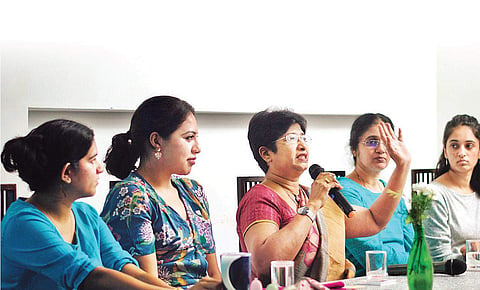

CHENNAI : It’s 5.30 pm on a sunny Friday. Around 30 women across age groups are gathered at Goli Soda Store in Alwarpet, leaving behind their busy schedules, to discuss sustainable menstrual practices. The panelists comprised six well-known women — Lavanya Mohan, charted account & writer; Kavya Menon, representing Eco Femme; Dr Gita Arjun, gynaecologist; Rajee and Sneha Gireesh (mother and daughter) and Kavya Abraham, dancer and entrepreneur.
“We consume 15 pads for one cycle and 180 pads for a year. Imagine, we use 7,200 pads for forty years. If that’s the case for one person then considering the women population on earth makes it impossible to think of the amount of waste we’d be contributing in our life time. The perception of cloth pads being unhygienic, idea of carrying one around during travel for long hours and the shape and sizes of cloth pads need to be addressed especially among teenage and young adults,” said Lavanya Mohan, who was moderating the session.
“This is our second edition on sustainable menstrual practices. We’ve always worked with upcycled products in our store. Cloth pads and menstrual cups are a part of it,” said Sruti Hari, owner of Goli Soda Store. A common apprehension in the mind of every woman assembled there was the hygiene and feasibility factor behind menstrual cups and washable cloth pads.
“The disposable pads we commonly use are made of plastic, cotton gauze, cotton and selfabsorbent gel. These harmful chemicals cause rashes when rubbed against your thighs and groins, bad odour, and cannot be easily decomposed thereby resulting in pollution. The cloth pads are designed in different sizes with multiple leak proof layers.
The pads come along with buttons on the lower side to prevent them from moving. They have a longer life span and are pocket-friendly. I’ve personally used them during treks and travels,” said Kavya Menon, ambassador of Eco Femme, an Auroville- based brand that employs women through this. “Around 10-12 per cent of the population use cloth pads and it is a very minimal count. We all used cloth pads in the past. It wasn’t comfortable and never stayed in one place resulting in staining. Disposable pads was a boon. It was easy to use and throw. However, shifting to cloth pads can be one of the best decisions. The first step is to keep the shame and stigma aside.
These days pads are designed in a way that they can be dried along with clothes and it would look like just a napkin,” said Dr Gita Arjun. Among the panelists was a mother and daughter duo. Rajee (mother) started using cloth pads recently because of her daughter Sneha. Like every mother, she had her share of questions about the effectiveness and capacity of it during heavy bleeding.
However, Sneha shares her experience, “I was allergic to disposable pads and developed rashes. After I was convinced with my research about how it functions, I switched over to cloth pads. The change after use is instant, takes few days to adjust and helps develop a healthy lifestyle. I’m spreading this awareness among my friends and to my little sister.
My next step is to try out cups.” Compared to cloth pads, people are skeptical about cups made of silicone and rubber. “Once the cup sits correctly on the desired part, it does not move. It takes time to get used to it and it has to be removed properly. The cup has a good capacity too,” said Kavya Menon. The cloth pads are available on golisodastore.com